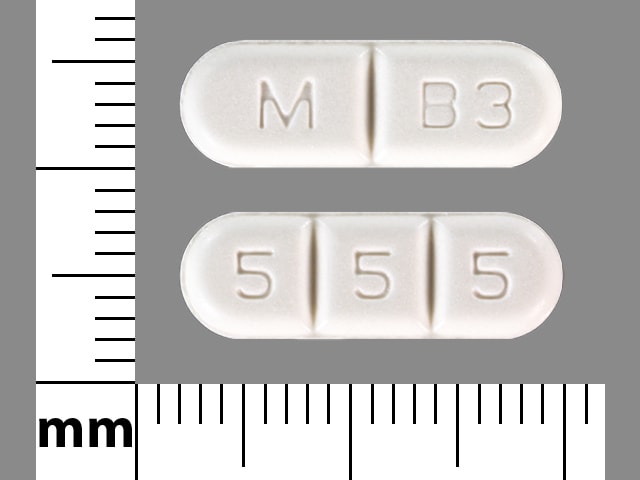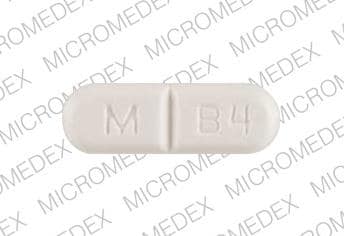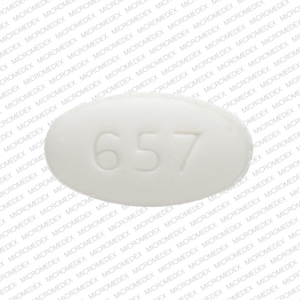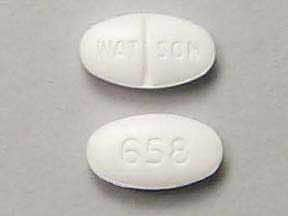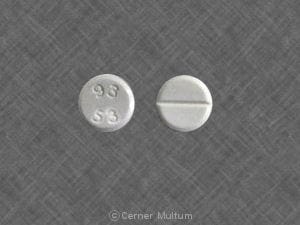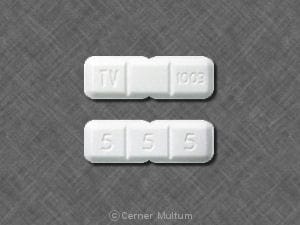Dosage Forms
Excipient information presented when available (limited, particularly for generics); consult specific product labeling.
Tablet, Oral, as hydrochloride:
Generic: 5 mg, 7.5 mg, 10 mg, 15 mg, 30 mg
Pharmacology
Mechanism of Action
The mechanism of action of buspirone is unknown. Buspirone has a high affinity for serotonin 5-HT1A and 5-HT2 receptors, without affecting benzodiazepine-GABA receptors. Buspirone has moderate affinity for dopamine D2 receptors.
Pharmacokinetics/Pharmacodynamics
Absorption
Rapid and complete; bioavailability is limited by extensive first-pass effect; only ~1% of the oral dose reaches the systemic circulation unchanged
Distribution
Vd: 5.3 L/kg (Gammans 1986)
Metabolism
Hepatic oxidation, primarily via CYP3A4 to several metabolites including an active metabolite, 1-pyrimidinylpiperazine (1-PP; exhibits about 25% of the activity of buspirone); extensive first-pass effect
Excretion
Urine: 29% to 63% (primarily as metabolites); feces: 18% to 38%
Time to Peak
Serum: 40 to 90 minutes
Half-Life Elimination
2 to 3 hours; increased with renal or hepatic impairment
Protein Binding
~86%
Use in Specific Populations
Special Populations: Renal Function Impairment
AUC increased 4-fold.
Special Populations: Hepatic Function Impairment
AUC increased 13-fold.
Use: Labeled Indications
Generalized anxiety disorder: Management of generalized anxiety disorder or the short-term relief of the symptoms of anxiety
Use: Off Label
Unipolar depression, augmentationbyes
Data from two randomized controlled trials in patients with nonpsychotic major depressive disorder without remission despite treatment with an SSRI (ie, citalopram and fluoxetine) support the use of buspirone as an augmentation strategy in the treatment of this condition. However, in comparison to bupropion, patients receiving buspirone had more adverse effects and less improvement in symptoms Appelberg 2001, Trivedi 2006. Additional trials may be necessary to further define the role of buspirone in this condition.
Based on the American Psychiatric Association (APA) practice guideline for the treatment of patients with major depressive disorder, buspirone (added to an SSRI) is an effective augmentation strategy for this condition.
Contraindications
Hypersensitivity to buspirone or any component of the formulation; concomitant use of MAOIs intended to treat depression or within 14 days of discontinuing MAOIs intended to treat depression; concomitant use of MAOIs within 14 days of discontinuing buspirone; initiation of buspirone in patients receiving reversible MAOIs (eg, linezolid, IV methylene blue).
Dosage and Administration
Dosing: Adult
Note: Periodically assess the usefulness of the drug for the individual patient.
Generalized anxiety disorder: Oral: Initial: 10 to 15 mg/day in 2 to 3 divided doses; may increase every 2 to 3 days in increments of 5 mg/day to a maximum of 60 mg/day; usual dose: 20 to 30 mg/day in 2 to 3 divided doses (Chessick 2006; Sramek 1999).
Unipolar depression, augmentation (alternative agent following antidepressant switch and other augmentation agents) (off-label use): Oral: Initial: 15 to 20 mg/day in 2 divided doses; may increase every 3 to 7 days in increments of 10 to 15 mg/day to a maximum of 60 mg/day in 2 divided doses (APA 2010; Appelberg 2001; Trivedi 2006).
Dosing: Geriatric
Refer to adult dosing.
Dosing: Pediatric
Anxiety disorders: Children and Adolescents: Oral: Limited information is available; dose is not well established. One pilot study of 15 children, 6-14 years of age (mean 10 years), with mixed anxiety disorders, used initial doses of 5 mg daily; doses were individualized with increases in increments of 5 mg/day every week as needed to a maximum dose of 20 mg/day divided into 2 doses; the mean dose required: 18.6 mg/day (Simeon, 1994). Some authors (Carrey, 1996 and Kutcher, 1992), based on their clinical experience, recommend higher doses (eg, 15-30 mg/day in 2 divided doses). An open-label study in 25 prepubertal inpatients (mean age: 8 ± 1.8 years; range: 5-11 years) with anxiety symptoms and moderately aggressive behavior used initial doses of 5 mg daily; doses were titrated upwards (over 3 weeks) by 5-10 mg every 3 days to a maximum dose of 50 mg/day; doses >5 mg/day were administered in 2 divided doses/day; buspirone was discontinued in 25% of the children due to increased aggression and agitation or euphoric mania; mean optimal dose (n=19): 28 mg/day; range: 10-50 mg/day; median: 30 mg/day (Pfeffer, 1997). Two placebo-controlled 6-week trials in children and adolescents (n=559; age: 6-17 years) with generalized anxiety disorder studied doses of 7.5-30 mg twice daily (15-60 mg/day); no significant differences between buspirone and placebo with respect to generalized anxiety disorder symptoms were observed (see package insert).
Administration
Oral: Administer with or without food, but must be consistent.
Dietary Considerations
Avoid large quantities of grapefruit juice.
Storage
Store at 20°C to 25°C (68°F to 77°F); excursions permitted between 15°C to 30°C (59°F to 86°F). Protect from light.
BusPIRone Images
Drug Interactions
Alcohol (Ethyl): BusPIRone may enhance the sedative effect of Alcohol (Ethyl). Avoid combination
Aprepitant: May increase the serum concentration of CYP3A4 Substrates (High risk with Inhibitors). Monitor therapy
Bosentan: May decrease the serum concentration of CYP3A4 Substrates (High risk with Inducers). Monitor therapy
Calcium Channel Blockers (Nondihydropyridine): May increase the serum concentration of BusPIRone. Exceptions: Bepridil. Monitor therapy
Clofazimine: May increase the serum concentration of CYP3A4 Substrates (High risk with Inhibitors). Monitor therapy
Conivaptan: May increase the serum concentration of CYP3A4 Substrates (High risk with Inhibitors). Avoid combination
CYP3A4 Inducers (Moderate): May decrease the serum concentration of CYP3A4 Substrates (High risk with Inducers). Monitor therapy
CYP3A4 Inducers (Strong): May decrease the serum concentration of BusPIRone. Management: Consider alternatives to this combination. If coadministration of these agents is deemed necessary, monitor patients for reduced buspirone effects and increase buspirone doses as needed. Consider therapy modification
CYP3A4 Inhibitors (Moderate): May decrease the metabolism of CYP3A4 Substrates (High risk with Inhibitors). Monitor therapy
CYP3A4 Inhibitors (Strong): May increase the serum concentration of BusPIRone. Management: Limit the buspirone dose to 2.5 mg daily and monitor patients for increased buspirone effects/toxicities if combined with strong CYP3A4 inhibitors. Exceptions: Nefazodone. Consider therapy modification
Dabrafenib: May decrease the serum concentration of CYP3A4 Substrates (High risk with Inducers). Management: Seek alternatives to the CYP3A4 substrate when possible. If concomitant therapy cannot be avoided, monitor clinical effects of the substrate closely (particularly therapeutic effects). Consider therapy modification
Deferasirox: May decrease the serum concentration of CYP3A4 Substrates (High risk with Inducers). Monitor therapy
Duvelisib: May increase the serum concentration of CYP3A4 Substrates (High risk with Inhibitors). Monitor therapy
Enzalutamide: May decrease the serum concentration of CYP3A4 Substrates (High risk with Inducers). Management: Concurrent use of enzalutamide with CYP3A4 substrates that have a narrow therapeutic index should be avoided. Use of enzalutamide and any other CYP3A4 substrate should be performed with caution and close monitoring. Consider therapy modification
Erdafitinib: May decrease the serum concentration of CYP3A4 Substrates (High risk with Inducers). Monitor therapy
Erdafitinib: May increase the serum concentration of CYP3A4 Substrates (High risk with Inhibitors). Monitor therapy
Erythromycin (Systemic): May increase the serum concentration of BusPIRone. Management: Limit the buspirone dose to 2.5 mg twice daily and monitor for increased buspirone effects/toxicities if combined with erythromycin. Consider therapy modification
Fosaprepitant: May increase the serum concentration of CYP3A4 Substrates (High risk with Inhibitors). Monitor therapy
Fosnetupitant: May increase the serum concentration of CYP3A4 Substrates (High risk with Inhibitors). Monitor therapy
Fusidic Acid (Systemic): May increase the serum concentration of CYP3A4 Substrates (High risk with Inhibitors). Avoid combination
Grapefruit Juice: May increase the serum concentration of BusPIRone. Management: Monitor for increased effect of buspirone if combined with grapefruit juice. Patients should avoid consuming large quantities of grapefruit juice. Consider therapy modification
Idelalisib: May increase the serum concentration of CYP3A4 Substrates (High risk with Inhibitors). Avoid combination
Ioflupane I 123: BusPIRone may diminish the diagnostic effect of Ioflupane I 123. Monitor therapy
Ivosidenib: May decrease the serum concentration of CYP3A4 Substrates (High risk with Inducers). Monitor therapy
Larotrectinib: May increase the serum concentration of CYP3A4 Substrates (High risk with Inhibitors). Monitor therapy
Linezolid: BusPIRone may enhance the serotonergic effect of Linezolid. This could result in serotonin syndrome. Avoid combination
Lorcaserin: May enhance the serotonergic effect of Serotonergic Agents (Moderate Risk, Miscellaneous). This could result in serotonin syndrome. Management: Monitor for signs and symptoms of serotonin syndrome/serotonin toxicity (eg, hyperreflexia, clonus, hyperthermia, diaphoresis, tremor, autonomic instability, mental status changes) when these agents are combined. Monitor therapy
Lorlatinib: May decrease the serum concentration of CYP3A4 Substrates (High risk with Inducers). Management: Avoid concurrent use of lorlatinib with any CYP3A4 substrates for which a minimal decrease in serum concentrations of the CYP3A4 substrate could lead to therapeutic failure and serious clinical consequences. Consider therapy modification
Methylene Blue: BusPIRone may enhance the serotonergic effect of Methylene Blue. This could result in serotonin syndrome. Avoid combination
MiFEPRIStone: May increase the serum concentration of CYP3A4 Substrates (High risk with Inhibitors). Management: Minimize doses of CYP3A4 substrates, and monitor for increased concentrations/toxicity, during and 2 weeks following treatment with mifepristone. Avoid cyclosporine, dihydroergotamine, ergotamine, fentanyl, pimozide, quinidine, sirolimus, and tacrolimus. Consider therapy modification
Mitotane: May decrease the serum concentration of CYP3A4 Substrates (High risk with Inducers). Management: Doses of CYP3A4 substrates may need to be adjusted substantially when used in patients being treated with mitotane. Consider therapy modification
Monoamine Oxidase Inhibitors (Antidepressant): BusPIRone may enhance the serotonergic effect of Monoamine Oxidase Inhibitors (Antidepressant). This could result in serotonin syndrome. Avoid combination
Monoamine Oxidase Inhibitors (Type B): May enhance the serotonergic effect of Serotonergic Agents (Moderate Risk, Miscellaneous). This could result in serotonin syndrome. Management: Monitor for signs and symptoms of serotonin syndrome/serotonin toxicity (eg, hyperreflexia, clonus, hyperthermia, diaphoresis, tremor, autonomic instability, mental status changes) when these agents are combined. Monitor therapy
Nefazodone: BusPIRone may enhance the serotonergic effect of Nefazodone. This could result in serotonin syndrome. Nefazodone may increase the serum concentration of BusPIRone. Management: Limit the buspirone dose to 2.5 mg daily and monitor patients for increased buspirone effects/toxicities, including serotonin syndrome, if combined with nefazodone. Consider therapy modification
Netupitant: May increase the serum concentration of CYP3A4 Substrates (High risk with Inhibitors). Monitor therapy
Oxitriptan: May enhance the serotonergic effect of Serotonergic Agents (Moderate Risk, Miscellaneous). This could result in serotonin syndrome. Management: Monitor for signs and symptoms of serotonin syndrome/serotonin toxicity (eg, hyperreflexia, clonus, hyperthermia, diaphoresis, tremor, autonomic instability, mental status changes) when these agents are combined. Monitor therapy
Palbociclib: May increase the serum concentration of CYP3A4 Substrates (High risk with Inhibitors). Monitor therapy
Resveratrol: May increase the serum concentration of BusPIRone. Monitor therapy
Sarilumab: May decrease the serum concentration of CYP3A4 Substrates (High risk with Inducers). Monitor therapy
Serotonergic Agents (High Risk): BusPIRone may enhance the serotonergic effect of Serotonergic Agents (High Risk). This could result in serotonin syndrome. Management: Monitor for signs and symptoms of serotonin syndrome/serotonin toxicity (eg, hyperreflexia, clonus, hyperthermia, diaphoresis, tremor, autonomic instability, mental status changes) when these agents are combined. Exceptions: Isocarboxazid; Linezolid; Methylene Blue; Moclobemide; Nefazodone; Phenelzine; Tranylcypromine. Monitor therapy
Siltuximab: May decrease the serum concentration of CYP3A4 Substrates (High risk with Inducers). Monitor therapy
Simeprevir: May increase the serum concentration of CYP3A4 Substrates (High risk with Inhibitors). Monitor therapy
St John's Wort: BusPIRone may enhance the serotonergic effect of St John's Wort. This could result in serotonin syndrome. St John's Wort may decrease the serum concentration of BusPIRone. Management: Monitor for signs and symptoms of serotonin syndrome/serotonin toxicity (eg, hyperreflexia, clonus, hyperthermia, diaphoresis, tremor, autonomic instability, mental status changes) and for reduced buspirone efficacy when these agents are combined. Monitor therapy
Stiripentol: May increase the serum concentration of CYP3A4 Substrates (High risk with Inhibitors). Management: Use of stiripentol with CYP3A4 substrates that are considered to have a narrow therapeutic index should be avoided due to the increased risk for adverse effects and toxicity. Any CYP3A4 substrate used with stiripentol requires closer monitoring. Consider therapy modification
Tocilizumab: May decrease the serum concentration of CYP3A4 Substrates (High risk with Inducers). Monitor therapy
Yohimbine: May diminish the therapeutic effect of Antianxiety Agents. Monitor therapy
Test Interactions
The presence of buspirone may result in a false positive on a urinary assay for metanephrine/catecholamine; discontinue buspirone ≥48 hours prior to collection of urine sample for catecholamines.
Adverse Reactions
>10%: Central nervous system: Dizziness (3% to 12%)
1% to 10%:
Cardiovascular: Chest pain (≥1%)
Central nervous system: Drowsiness (10%), headache (6%), nervousness (5%), confusion (2%), excitement (2%), numbness (2%), outbursts of anger (2%), abnormal dreams (≥1%), ataxia (1%) paresthesia (1%)
Dermatologic: Diaphoresis (1%), skin rash (1%)
Gastrointestinal: Nausea (8%), diarrhea (2%), sore throat (≥1%)
Neuromuscular & skeletal: Weakness (2%), musculoskeletal pain (1%), tremor (1%)
Ophthalmic: Blurred vision (2%)
Otic: Tinnitus (≥1%)
Respiratory: Nasal congestion (≥1%)
<1%, postmarketing, and/or case reports: Acne vulgaris, akathisia, alcohol abuse, alopecia, altered sense of smell, amenorrhea, angioedema, anorexia, apathy, arthralgia, bradycardia, bruise, cardiac failure, cardiomyopathy, cerebrovascular accident, change in libido, claustrophobia, cogwheel rigidity, cold intolerance, conjunctivitis, delayed ejaculation, depersonalization, dissociative reaction, dysgeusia, dyskinesia, dysphoria, dyspnea, dystonia, dysuria, edema, emotional lability, eosinophilia, epistaxis, euphoria, extrapyramidal reaction, eye pain, facial edema, fear, fever, flatulence, flushing, galactorrhea, glossopyrosis, hallucination, hemorrhagic diathesis, hiccups, hyperacusis, hypersensitivity reaction, hypertension, hyperventilation, hypotension, impotence, increased appetite, increased intraocular pressure, increased serum ALT, increased serum AST, increased serum transaminases, inner ear disturbance, involuntary muscle movements, irritable bowel syndrome, laryngitis, leukopenia, malaise, memory impairment, menstrual disease, muscle cramps, muscle spasm, myocardial infarction, nocturia, parkinsonian-like syndrome, pelvic inflammatory disease, personality disorder, photophobia, pruritus, psychosis, rectal hemorrhage, restless leg syndrome, restlessness, roaring sensation in head, salivation, seizure, serotonin syndrome, skin blister, slowed reaction time, slurred speech, stiffness, stupor, suicidal ideation, syncope, thinning of nails, thrombocytopenia, thyroid disease, urinary frequency, urinary hesitancy, urinary incontinence, urinary retention, urticaria, vertigo, visual disturbance (tunnel vision), weight gain, weight loss, xeroderma
Warnings/Precautions
Concerns related to adverse effects:
- Akathisia: Akathisia, or restlessness, has been reported in small number of patients; may be a result of central dopamine receptor antagonism. Monitor for signs of any dopamine-related movement disorders (eg, dystonia, akathisia, pseudo-parkinsonism, tardive dyskinesia).
- CNS depression: May rarely cause CNS depression, which may impair physical or mental abilities; patients must be cautioned about performing tasks that require mental alertness (eg, operating machinery or driving).
- Serotonin syndrome: Potentially life-threatening serotonin syndrome has occurred with serotonergic agents, including buspirone, particularly when used in combination with other serotonergic agents (eg, triptans, TCAs, fentanyl, lithium, tramadol, buspirone, St John's wort, tryptophan) or agents that impair metabolism of serotonin (eg, MAOIs intended to treat psychiatric disorders, other MAOIs [ie, linezolid and IV methylene blue]). Monitor patients closely for signs of serotonin syndrome, such as mental status changes (eg, agitation, hallucinations, delirium, coma); autonomic instability (eg, tachycardia, labile blood pressure, diaphoresis, flushing, hyperthermia); neuromuscular changes (eg, tremor, rigidity, myoclonus); GI symptoms (eg, nausea, vomiting, diarrhea); and/or seizures. Discontinue treatment (and any concomitant serotonergic agent) immediately if signs/symptoms arise.
Disease-related concerns:
- Hepatic impairment: Use caution in patients with hepatic impairment; use in severe hepatic impairment is not recommended.
- Renal impairment: Use caution in patients with renal impairment; use in severe renal impairment is not recommended.
Concurrent drug therapy issues:
- Drug-drug interactions: Potentially significant interactions may exist, requiring dose or frequency adjustment, additional monitoring, and/or selection of alternative therapy. Consult drug interactions database for more detailed information.
Other warnings/precautions:
- Sedative/hypnotic withdrawal: Buspirone does not exhibit cross-tolerance with benzodiazepines or other sedative/hypnotic agents. If substituting buspirone for any of these agents, gradually withdraw the drug(s) prior to initiating buspirone.
Monitoring Parameters
Mental status, symptoms of anxiety, signs/symptoms of serotonin syndrome.
Pregnancy
Pregnancy Risk Factor
B
Pregnancy Considerations
Adverse events have not been observed in animal reproduction studies.
Patient Education
What is this drug used for?
- It is used to treat anxiety.
- It may be given to you for other reasons. Talk with the doctor.
Frequently reported side effects of this drug
- Fatigue
- Dizziness
- Anxiety
- Headache
- Nausea
Other side effects of this drug: Talk with your doctor right away if you have any of these signs of:
- Serotonin syndrome like dizziness, severe headache, agitation, sensing things that seem real but are not, fast heartbeat, abnormal heartbeat, flushing, tremors, sweating a lot, change in balance, severe nausea, or severe diarrhea.
- Agitation
- Abnormal movements
- Twitching
- Change in balance
- Difficulty speaking
- Difficulty swallowing
- Signs of a significant reaction like wheezing; chest tightness; fever; itching; bad cough; blue skin color; seizures; or swelling of face, lips, tongue, or throat.
Note: This is not a comprehensive list of all side effects. Talk to your doctor if you have questions.
Consumer Information Use and Disclaimer: This information should not be used to decide whether or not to take this medicine or any other medicine. Only the healthcare provider has the knowledge and training to decide which medicines are right for a specific patient. This information does not endorse any medicine as safe, effective, or approved for treating any patient or health condition. This is only a brief summary of general information about this medicine. It does NOT include all information about the possible uses, directions, warnings, precautions, interactions, adverse effects, or risks that may apply to this medicine. This information is not specific medical advice and does not replace information you receive from the healthcare provider. You must talk with the healthcare provider for complete information about the risks and benefits of using this medicine.
